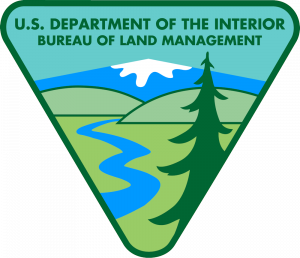Vectorspace (talk | contribs) |
Vectorspace (talk | contribs) |
||
| Line 28: | Line 28: | ||
BLM does not appear to have a consistent and approved functional classification schema. The best reference is a 2006 study and report on Roads and Trails Terminology that suggests three levels of classification for BLM roads. | BLM does not appear to have a consistent and approved functional classification schema. The best reference is a 2006 study and report on Roads and Trails Terminology that suggests three levels of classification for BLM roads. | ||
[[file: BLM_roads_1.png | center | 400px]] | |||
<small> | <small> | ||
| Line 37: | Line 38: | ||
|- style="vertical-align:top;" | |- style="vertical-align:top;" | ||
|style="text-align:center;" |Road | |style="text-align:center;" |Road | ||
|style="text-align: | |style="text-align:left;" |A linear route declared a road by the owner, managed for | ||
use by low-clearance vehicles having four or more wheels, and maintained for regular and continuous use. | use by low-clearance vehicles having four or more wheels, and maintained for regular and continuous use. | ||
|style="text-align:left;" |Street<br>Primary Street | |style="text-align:left;" |Street<br>Primary Street | ||
|- style="vertical-align:top;" | |- style="vertical-align:top;" | ||
|style="text-align:center;" |Primative<br>Road | |style="text-align:center;" |Primative<br>Road | ||
|style="text-align: | |style="text-align:left;" |A linear route managed for use by four-wheel drive or high-clearance vehicles. Primitive roads do not normally meet any BLM road design standards. | ||
|style="text-align:left;" |4x4 Trail | |style="text-align:left;" |Dirt Road / 4x4 Trail | ||
|- style="vertical-align:top;" | |- style="vertical-align:top;" | ||
|style="text-align:center;" |Trail | |style="text-align:center;" |Trail | ||
|style="text-align: | |style="text-align:left;" |A linear route managed for use by four-wheel drive or high-clearance vehicles. Primitive roads do not normally meet any BLM road design standards. | ||
|style="text-align:left;" |Do Not Map | |style="text-align:left;" |Do Not Map | ||
|} | |} | ||
</small> | </small> | ||
== Editing Resources == | == Editing Resources == | ||
Revision as of 06:48, 9 March 2014
| This new page is currently undergoing modifications. The information presented should be considered a draft, not yet ready for use. Content is being prepared by one or more users. Do not make any changes before you send a private message to this user. Please use the talk page for thoughts and ideas on setting up this content. |
| Last update 8Mar14 |
Background

The Bureau of Land Management (BLM) is a United States Department of the Interior agency that administers public land in the United States. Most of this land is located in the western states and Alaska. It's mission is to sustain the health, diversity and productivity of the public lands for the use and enjoyment of present and future generations.
BLM's regulatory role in recreation use (some national monuments, camping, boating, hunting, fishing, mounting biking, driving, etc.) and commercial use (mining of minerals, coal, gas, oil, forestry, grazing, etc.) of public land means that Wazers may navigate to these locations for business and fun.
In one 2006 report (1), the BLM manages over 82,000 miles of road and more than 16,000 miles of trails. Through discussion with BLM staff, this document has not been fully adopted and there is no existing BLM-wide standard on road naming, maintenance levels, and road classification. Yet, from this document, it is clear that BLM roads and land take a different approach than other public lands such as the US Forest Service (USFS) and National Park Service (NPS).
BLM Lands seem typically less structured, supervised, and maintained than USFS and NPS and therefore are trending toward a simpler three-tier road categorization as follows:
- Road: Managed for use by low-clearance vehicles having four or more wheels, and maintained for regular and continuous use.
- Primitive Road: Mannaged for use by four-wheel drive or high-clearance vehicles.
- Trail: Managed for human-powered, animal (like horse), or off-highway vehicle (like dirt bike, motorcycle)Trails are not generally managed for use by four-wheel drive or high-clearance vehicles.
Waze and BLM
Creating accurate and properly represented BLM landmarks and roads:
- Benefit tourists and recreational users of NPS faculties,
- Better enables commercial use of BLM lands,
- Allows Wazers to more quickly find important landmarks, such as monuments, campgrounds, and visitor centers.
Functional Classification
BLM does not appear to have a consistent and approved functional classification schema. The best reference is a 2006 study and report on Roads and Trails Terminology that suggests three levels of classification for BLM roads.

| BLM Type |
Description | Suggested Waze Road Treatment |
| Road | A linear route declared a road by the owner, managed for
use by low-clearance vehicles having four or more wheels, and maintained for regular and continuous use. |
Street Primary Street |
| Primative Road |
A linear route managed for use by four-wheel drive or high-clearance vehicles. Primitive roads do not normally meet any BLM road design standards. | Dirt Road / 4x4 Trail |
| Trail | A linear route managed for use by four-wheel drive or high-clearance vehicles. Primitive roads do not normally meet any BLM road design standards. | Do Not Map |
Editing Resources
National Monuments
BLM's National Conservation Lands include 19 national monuments in western states of Arizona, California, Colorado, Idaho, Montana, New Mexico, Oregon, Utah, and Washington. See their National Monuments for details. These will be likely destinations for Wazers.
Similar Road Systems
References
(1) Roads and Trails Terminology Report, 2006
(2) Discussions with BLM staff.